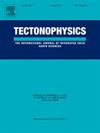2022年兴汤加火山喷发Lamb波的面应变响应
IF 2.7
3区 地球科学
Q2 GEOCHEMISTRY & GEOPHYSICS
引用次数: 0
摘要
2022年1月15日,有记录以来最大的Hunga-Tonga火山喷发产生了羽流,导致大气波从火山中心传播到周围地区。虽然研究报告了对这次喷发的多参数响应,但对地表远场面应变的研究仍然不足。本文采用距离火山震中约8700 ~ 13500 km远场应变张量的7个参数,研究它们对火山喷发产生的兰姆波的响应。结果表明,从应变曲线中可以清楚地提取出至少三个摄动,表明Lamb波以大约320 m/s的相同速度从相反的方向绕地球传播了几次,每次持续约30.5 h。对于表面剪切应变,我们将坐标系旋转到Lamb波传播的径向和切向,发现径向应变的振幅是切向应变的两倍。莫尔应变圆反映的主应变与兰姆波的传播方向一致。结果表明,火山喷发是通过空气中兰姆波引起的气岩相互作用引起波动的。本文章由计算机程序翻译,如有差异,请以英文原文为准。
Areal strain responses to Lamb waves generated from 2022 Hunga-Tonga volcano eruption
On 15 January 2022, the largest Hunga-Tonga volcano eruption ever recorded produced a plume, causing atmospheric waves that propagated from the volcanic epicenter to the surrounding areas. Although studies have reported multi-parameter responses to this eruption, the far-field areal strain on the surface remained underexplored. Here we adopted 7 parameters of the strain tensors in the far-field about 8700–13,500 km from the volcano epicenter to study their responses to the generated Lamb waves from the eruption. The results showed that at least triple perturbations could be picked up clearly from the strain curves, indicating Lamb waves propagated several times around the globe from opposite directions at the same speed of approximately 320 m/s, each lasting about 30.5 h. For the surface shear strain, we rotated the coordinates system to the radial and tangential direction of Lamb wave propagation, and found that the amplitude of the radial strain was twice that of the tangential strain. Additionally, the principal strain reflected by the Mohr strain circles is consistent with the propagation direction of Lamb waves. The results indicate that the volcano eruption caused fluctuations via the air-rock interaction induced by Lamb waves in the air.
求助全文
通过发布文献求助,成功后即可免费获取论文全文。
去求助
来源期刊

Tectonophysics
地学-地球化学与地球物理
CiteScore
4.90
自引率
6.90%
发文量
300
审稿时长
6 months
期刊介绍:
The prime focus of Tectonophysics will be high-impact original research and reviews in the fields of kinematics, structure, composition, and dynamics of the solid arth at all scales. Tectonophysics particularly encourages submission of papers based on the integration of a multitude of geophysical, geological, geochemical, geodynamic, and geotectonic methods
 求助内容:
求助内容: 应助结果提醒方式:
应助结果提醒方式:


